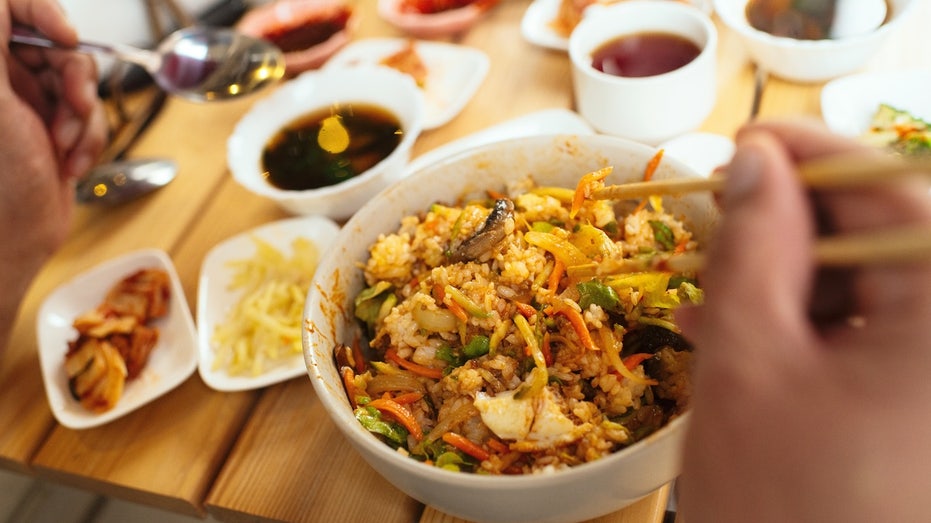
Researchers found that brown rice contains more of the carcinogenic inorganic arsenic than white rice, prompting calls for balanced nutrition and food safety awareness.
While white rice is still the most popular among consumers, brown rice is often praised for its nutritional benefits.
A new study, however, raises concerns about brown rice containing a higher level of arsenic than white rice.
The study was led by Michigan State University and published in the journal Risk Analysis.
CELEBRITY CHEF GUY FIERI’S MESSAGE TO AMERICANS: LET’S ‘EAT BETTER’ TO LIVE BETTER
Rice traditionally has its inedible outer hull removed. Brown rice gets its color from the bran and germ layer of rice, according to Healthline.
White rice is the same grain with the hull, bran layer and cereal germ removed — leaving only the soft, white interior.
The bran layer and cereal germ are what make brown rice nutritionally superior to white rice, because these layers are rich in fiber, vitamins and minerals.
Researchers conducted an extensive literature review on the nutritional aspects of brown and white rice, focusing on the level of arsenic exposure for each.
They drew from the “What We Eat in America” database — from the U.S. Environmental Protection Agency (EPA) and Joint Institute of Food Science and Applied Nutrition — to determine how much rice the average American consumes, according to a news release.
ARE ROTISSERIE CHICKENS REALLY HEALTHY? WHAT TO KNOW
Researchers found the rice bran that comprises the tan layer of brown rice has a much higher concentration of inorganic arsenic than the white part of the rice.
“Rice bran and brown rice are shown to have a higher arsenic content and inorganic arsenic concentration than the grain endosperm of white rice,” researchers wrote in the study.
Their analysis revealed that with rice grown in the U.S., the proportion of the more toxic, inorganic arsenic in brown rice was 48%, compared to 33% in white rice.
Sherry Coleman Collins, a food allergy dietitian and expert from the Atlanta metropolitan area, was not involved in the study but said it highlights the importance of eating a diverse diet.
“We know that arsenic and other naturally occurring toxins and man-contributed pollutants are in the soil and that these can and do make their way into our food supply,” she told Fox News Digital in an interview.
“For this reason, eating a variety of foods — with adequate amounts of macronutrients, vitamins, minerals and fiber — is essential to reducing exposure to potentially harmful substances.”
“This research is important because it acknowledges the importance of considering food safety along with nutrition when consumers make choices about food,” said senior study author Felicia Wu, John A. Hannah Distinguished Professor and University Distinguished Professor at MSU’s College of Agriculture and Natural Resources, in the press release.
There are several forms of arsenic in rice, both organic and inorganic. Inorganic arsenic is a known human carcinogen, meaning it can cause cancer, researchers noted.
Arsenic is a natural component of the earth’s crust, according to the World Health Organization, and is widely distributed throughout the environment in the air, water and land.
“It is highly toxic in its inorganic form,” the site says.
Rice, which is very porous, can absorb a lot of inorganic arsenic from the flooded fields in which it grows, dietitian Devon Wagner wrote on Ohio State University’s Health & Discovery page.
“Rice can soak up more arsenic than any other food crop,” Wagner stated.
When the brown rice soaks up this inorganic arsenic, it becomes highly concentrated in that tan layer — which means that those consuming it may have higher exposure to the carcinogen.
Children under age 5 consume the most rice per unit of body weight, according to the study.
Children ages 6 to 24 months consume a higher level of brown rice, which could lead to a heightened exposure to arsenic, per the study.
“These elevated consumptive levels are additionally concerning, because rice consumption statistics often underestimate consumption by the very young,” the researchers warned.
The daily intake of inorganic arsenic among young children even exceeds previously considered safe levels, according to this research.
Adults don’t face this same high risk, researchers said, as they are not as affected by the differences in arsenic exposure, especially those who are ages 60 and over.
For more Lifestyle articles, visit foxnews.com/lifestyle
Collins confirmed that children are at higher risk, as their smaller size makes it more likely that the small amounts of arsenic would be acutely dangerous.
“There are a lot of infant and toddler foods that include brown rice, including cereals, puffs and puréed vegetables that are mixed with brown rice,” she told Fox News Digital.
CHEWING GUM MAY RELEASE THOUSANDS OF MICROPLASTICS INTO THE SALIVA, STUDY SAYS
“Theoretically and based on this data, those foods may expose babies and young children to higher levels of arsenic — however, the FDA does have guidance for manufacturers requiring them to maintain inorganic arsenic at or below 100 μg/kg or 100 ppb.”
Diversifying the diet of babies and people of all ages can be protective, she added.
“The concentrated amount of inorganic arsenic found within the rice bran in analysis challenges a common narrative of rice bran as a health product ‘superfood’ because of its increased nutrients and high fiber,” the researchers stated.
The findings, however, should not be regarded as evidence that brown rice is unhealthy — nor should people stop consuming it, according to Wu.
The study emphasized the importance of considering food safety concerns while balancing the nutritional benefits.
Those wondering whether to change their rice consumption should consult a health professional to understand the costs and benefits of switching.
“We concluded with a discussion of the need for more research into the potential trade-offs and relative arsenic exposure risks associated with brown versus white rice,” the researchers concluded.
Collins agreed that people should continue to eat brown rice for the health benefits — including fiber, magnesium and B vitamins — but should also eat quinoa, farro, buckwheat, barley and other grains.
CLICK HERE TO SIGN UP FOR OUR LIFESTYLE NEWSLETTER
“White rice is not a bad choice either, and it has lower levels of arsenic,” she noted. “I tend to encourage people to choose whole grains (white rice has had the bran and germ removed, meaning it has less fiber and lower levels of vitamins and minerals), but it’s completely OK to also enjoy white rice.”
Fox News Digital reached out to several rice manufacturers requesting comment.





